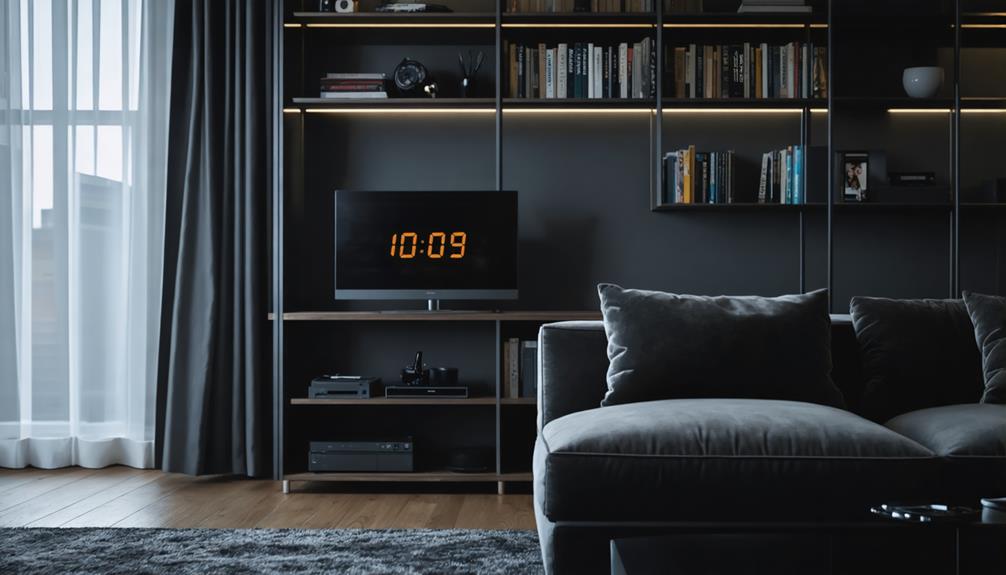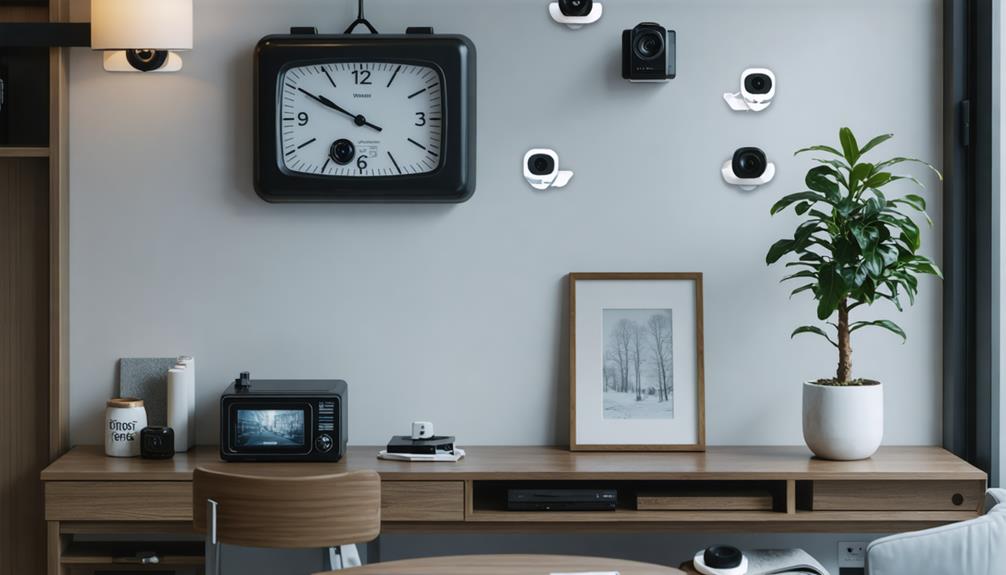
Brainstorm Security Shop

For Orders Over $199

On Any Of Our Products

Details On Refund Page
In the realm of surveillance technology, the use of spy cameras disguised as ordinary objects has sparked both intrigue and controversy, raising pertinent questions about privacy and security. These covert devices, ingeniously concealed within innocuous items like clocks or smoke detectors, offer unparalleled stealth in monitoring varied environments. Yet, as their prevalence grows, so too does the debate surrounding ethical use and regulatory compliance. What boundaries should be set to balance innovation with privacy rights? As we navigate this complex landscape, the implications for personal and institutional security continue to unfold, inviting further scrutiny and discussion.
When it comes to surveillance, disguised spy cameras have evolved to blend seamlessly into everyday environments, making detection increasingly challenging. These hidden cameras are expertly designed for covert surveillance, ensuring that their presence remains unnoticed by even the most observant individuals.
Various types of disguised spy cameras cater to different surveillance needs and contexts, each offering unique advantages. One common type is the smoke detector camera, which capitalizes on its strategic ceiling placement to capture a broad view of the room.
Clock cameras, often placed on desks or walls, are another popular option, providing an unobtrusive way to monitor activity without arousing suspicion. For those seeking portability, pen cameras offer an excellent solution, allowing users to carry their covert surveillance device with them wherever they go.
Additionally, USB charger cameras are growing in popularity due to their dual utility and inconspicuous appearance, as they can be plugged into any socket without raising eyebrows.
These devices showcase the ingenuity behind modern surveillance, where functionality and discretion are paramount. As technology continues to advance, the range and capabilities of disguised spy cameras will undoubtedly expand, further enhancing their effectiveness in covert surveillance operations.
Spy cameras, when expertly disguised, can significantly enhance home security by providing discreet surveillance that deters intruders without alerting them to its presence.
Beyond security, these devices serve as invaluable tools for wildlife observation, allowing researchers and enthusiasts to monitor animal behavior in their natural habitats without causing disruption.
This dual capability underscores the versatility of spy cameras in applications that range from protecting personal property to advancing scientific knowledge.
In the realm of home security enhancement, innovative uses of spy cameras have emerged as a game-changing development. With ongoing technology advancements, these discreet devices are now seamlessly integrated into existing security systems, providing a robust layer of protection.
Security integration has become more sophisticated, allowing homeowners to monitor their properties with greater precision and minimal intrusion. Spy cameras, cleverly disguised as everyday household objects, ensure that surveillance remains unobtrusive, yet highly effective.
The integration of spy cameras into smart home ecosystems exemplifies the intersection of innovation and practicality. These devices can be effortlessly controlled via mobile applications, granting homeowners real-time access to live footage from virtually anywhere.
This technological progression not only enhances security but also empowers users to respond promptly to any suspicious activity.
Moreover, the evolution of high-definition imaging and night vision capabilities in spy cameras has significantly improved their efficacy. Crisp, clear visuals are now possible even in low-light conditions, ensuring continuous surveillance around the clock.
As we continue to witness advancements in artificial intelligence, future developments may include features such as motion detection and facial recognition, further solidifying spy cameras as indispensable tools in modern home security systems.
Amidst the dense foliage of remote wilderness, spy cameras have emerged as invaluable tools for wildlife observation, offering an unobtrusive means to study animal behavior in their natural habitats. These sophisticated devices, often equipped with camouflage designs, blend seamlessly into the environment, minimizing human interference and allowing researchers to collect accurate data on species that are typically elusive or nocturnal.
The use of spy cameras in ecological studies has revolutionized the way scientists gather information about wildlife behavior. By capturing high-resolution images and videos, researchers can monitor feeding habits, mating rituals, and social interactions without disturbing the subjects. This unobtrusive surveillance is crucial in maintaining the integrity of the natural environment and ensuring that the presence of humans does not alter the animals’ behavior.
Moreover, the adaptability of these cameras is enhanced by their advanced features such as motion detection and night vision, enabling continuous monitoring day and night. These attributes make spy cameras an essential tool for conservation efforts, providing insights that inform policy decisions and habitat preservation strategies.
Ultimately, the integration of spy cameras into wildlife research is contributing significantly to our understanding of biodiversity and the ecological dynamics of our planet.

The use of disguised spy cameras raises significant ethical concerns, particularly regarding the invasion of personal space and the necessity for informed consent.
Legal boundaries are often tested as these devices can be easily used to capture footage without the knowledge of those being observed.
This type of surveillance not only challenges individuals’ privacy rights but can also lead to a broader erosion of trust in personal and professional environments.
Beyond their intended functionalities, spy cameras disguised in everyday objects raise significant ethical concerns, particularly regarding the invasion of personal space and privacy issues. The covert nature of these devices leads to the erosion of personal boundaries and undermines privacy rights, fostering an environment rife with trust issues.
As individuals become increasingly aware of being potentially monitored, the psychological effects can be profound, leading to anxiety and discomfort. The pervasive surveillance culture cultivated by these hidden cameras poses ethical dilemmas, challenging the balance between security and personal freedom.
It raises crucial questions about the extent to which surveillance should intrude into private lives. Furthermore, the social implications are vast, as relationships can be strained by the fear of being observed without consent. This highlights the necessity for robust consent education, ensuring that individuals are informed about their rights and the implications of being surveilled.
Additionally, data protection becomes a pressing concern, as unauthorized recordings contribute to an unwanted digital footprint. The need for stringent data protection measures to safeguard against misuse and unauthorized distribution of captured content is paramount.
These issues collectively underscore the urgent need to address the ethical and privacy challenges posed by disguised spy cameras.
Navigating consent and legal boundaries in the context of disguised spy cameras requires a nuanced understanding of both ethical concerns and privacy laws. The deployment of such devices often treads a fine line between acceptable and unacceptable practices, raising significant challenges.
To ensure compliance, individuals and organizations must consider:
The ethical considerations surrounding spy cameras underscore the importance of respecting privacy rights and adhering to surveillance laws. Breaches in these areas can lead to serious legal implications, highlighting the necessity for clear consent requirements and responsible surveillance practices.
Addressing these concerns is essential for maintaining integrity within any environment where surveillance may be warranted.
In today’s increasingly monitored world, the use of disguised spy cameras presents profound ethical concerns and privacy issues that threaten to erode trust within both personal and professional environments. The covert nature of these devices challenges core trust dynamics, fundamentally altering how individuals perceive their privacy. Surveillance ethics play a pivotal role in understanding the implications of such clandestine observation, sparking intense debate over the balance between security and personal freedoms.
| Aspect | Concern | Impact |
|---|---|---|
| Personal Privacy | Unauthorized Recording | Breach of Confidentiality |
| Workplace Surveillance | Employee Distrust | Reduced Morale and Productivity |
| Legal Implications | Regulatory Compliance | Potential Legal Repercussions |
| Ethical Considerations | Invasion of Personal Boundaries | Erosion of Social Trust |
| Technological Advancements | Unregulated Use | Increased Surveillance Capability |
The table above highlights key areas where trust dynamics are affected, illustrating the multifaceted consequences of unauthorized surveillance. The erosion of social trust is particularly concerning, as it can lead to a breakdown in community cohesion and interpersonal relationships. Furthermore, the potential for technological advancements to outpace regulatory frameworks poses a significant challenge for maintaining ethical surveillance practices. Thus, a balanced approach, grounded in transparency and accountability, is essential to address these pressing ethical concerns and preserve the integrity of privacy in society.
The deployment and use of spy cameras are subject to a complex array of legal regulations and compliance requirements that vary significantly across jurisdictions. These regulatory frameworks are designed to balance the potential benefits of surveillance technology with the imperative to protect individual privacy rights. Privacy laws often dictate stringent guidelines regarding the permissible contexts for using spy cameras, as well as the obligations of entities to notify individuals about surveillance.
Understanding these legal intricacies is essential for responsible and lawful use of spy cameras.

Selecting the appropriate spy camera is often a nuanced decision that requires careful consideration of various factors to ensure effectiveness and legality. The first step involves assessing the intended application, whether it’s for home security, business surveillance, or personal investigation. This context informs the choice of camera features such as resolution, night vision capabilities, and connectivity options.
For instance, high-resolution cameras with night vision are ideal for capturing clear footage in low-light conditions, while wireless connectivity enables remote access to live feeds.
Equally important are installation tips, which can significantly impact the functionality and discretion of the device. When installing a spy camera, selecting a location that provides a wide field of view without drawing attention is crucial.
Cameras disguised as everyday objects, such as clocks or smoke detectors, offer enhanced concealment and are easier to integrate into most environments. Additionally, ensuring the camera is positioned at an appropriate height and angle will maximize coverage while minimizing the risk of detection.
Legal compliance must always guide the selection process to avoid infringing on privacy rights. Thus, understanding and adhering to local laws concerning surveillance is imperative when choosing and installing a spy camera.
Anticipating advancements in spy technology requires a keen understanding of emerging innovations and their potential implications. As we look to the future, several trends promise to redefine the landscape of intelligence gathering. Chief among these are AI integration and miniaturization advancements, both of which are poised to revolutionize the efficacy and stealth of spy devices.
AI integration will enhance the analytical capabilities of spy technology, allowing devices to autonomously process and interpret data in real-time. This capability will enable more effective surveillance by identifying patterns and anomalies that would otherwise go unnoticed.
Additionally, advancements in miniaturization will allow spy cameras and other devices to become even smaller and more discreet, making them harder to detect and easier to deploy in a variety of environments.
Consider these potential developments:
These trends highlight a future where spy technology becomes more intelligent, stealthy, and efficient, raising both opportunities and ethical considerations for the industry.
Spy cameras remain undetected by employing advanced camouflage techniques, blending seamlessly into everyday objects. However, their usage raises significant concerns regarding surveillance ethics, necessitating a balance between security needs and respecting individual privacy rights in various environments.
Standard electronic devices can sometimes detect spy cameras through specific detection methods, such as identifying electronic interference. However, the effectiveness varies depending on the camera’s sophistication and the device’s capability to discern subtle electronic signals.
Exploring hidden gadgets reveals intriguing uses of stealth technology, with spy cameras ingeniously embedded in ordinary objects. Examples include coat hooks, smoke detectors, and even water bottles, demonstrating the innovative concealment of surveillance tools within everyday items.
Spy cameras, like other electronic devices, require regular maintenance to ensure optimal performance. Battery longevity is crucial; hence, periodic battery replacements are necessary. Maintenance tips include cleaning lenses and checking connections to sustain functionality and image clarity.
To ensure footage security from hackers, employ robust encryption methods to protect data transmission. Additionally, maintain stringent physical security measures, including secure storage and restricted access, to safeguard the camera and its recorded content from unauthorized interference.
Disguised spy cameras offer significant advancements in surveillance technology, seamlessly integrating into everyday environments for enhanced security and monitoring. These devices, while innovative, raise critical ethical and privacy issues that necessitate careful consideration and adherence to legal regulations. Selecting the appropriate spy camera involves balancing functionality with compliance, ensuring responsible use. As technology progresses, ongoing dialogue and regulation will be essential to address emerging trends and maintain public trust in surveillance practices.
